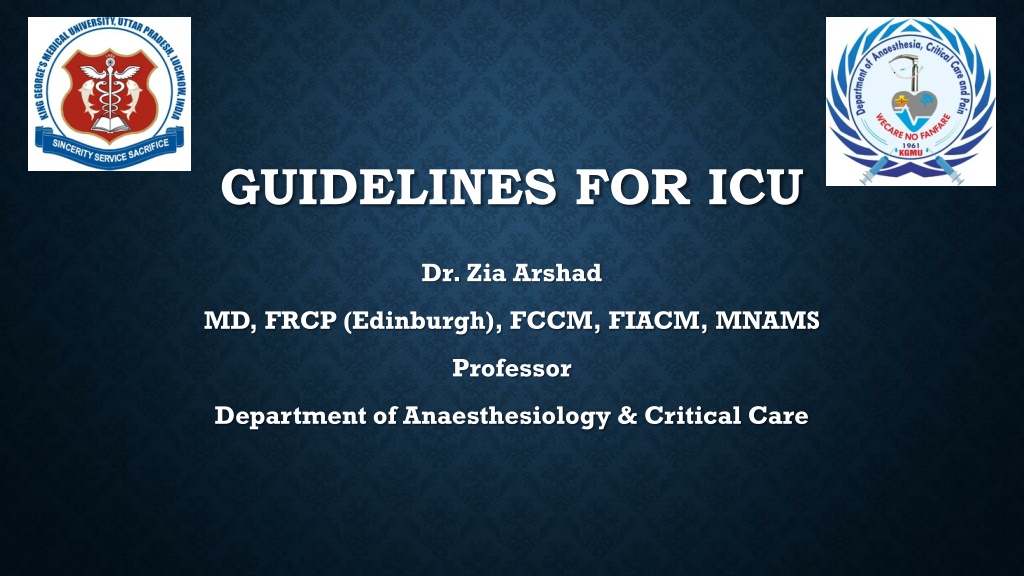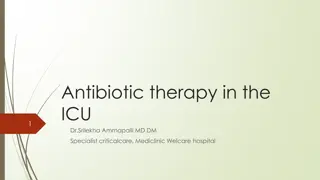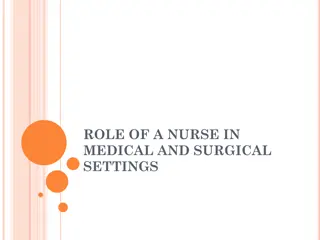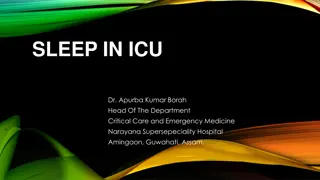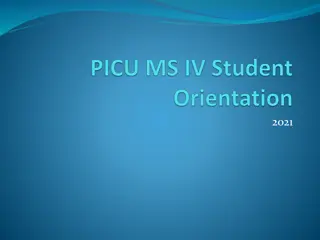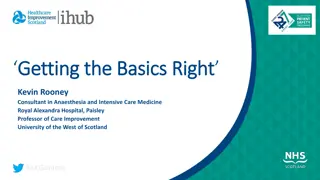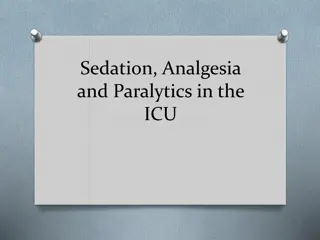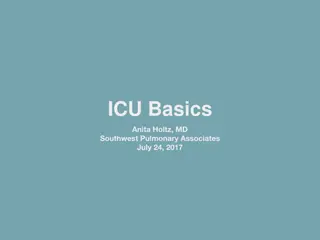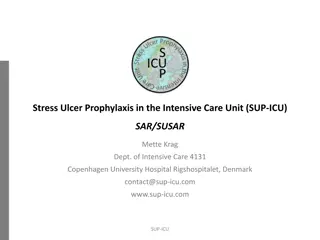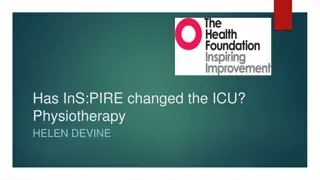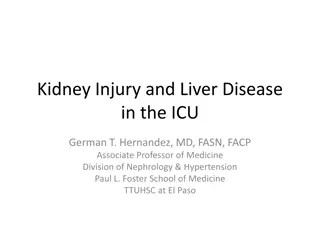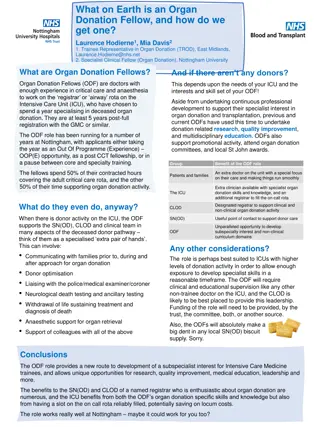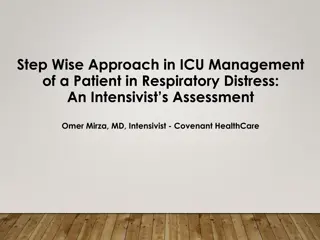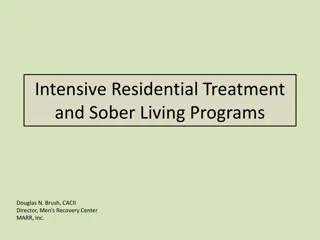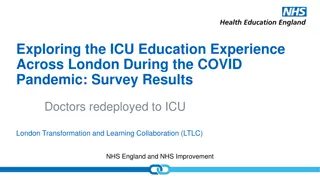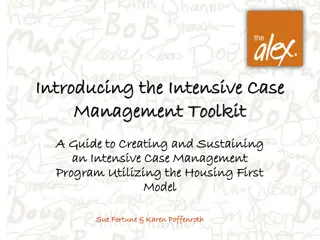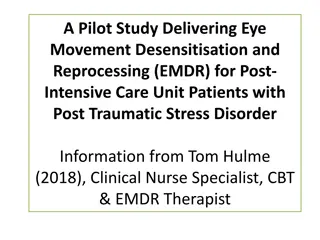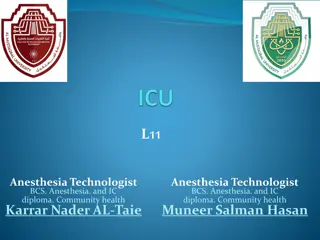Guidelines for Intensive Care Unit (ICU) Management by Dr. Zia Arshad
Dr. Zia Arshad provides comprehensive guidelines for managing patients in the ICU, including admission criteria, monitoring protocols, handling lab investigations, communication procedures, and post-mortem care. The guidelines emphasize meticulous documentation, compassionate patient care, infection control practices, and respectful treatment of deceased patients. Healthcare personnel are instructed to adhere to universal precautions, maintain strict hygiene practices, manage hospital waste properly, use appropriate antiseptics for indwelling devices, and ensure sterile dressing application for catheter insertion sites.
Download Presentation

Please find below an Image/Link to download the presentation.
The content on the website is provided AS IS for your information and personal use only. It may not be sold, licensed, or shared on other websites without obtaining consent from the author. Download presentation by click this link. If you encounter any issues during the download, it is possible that the publisher has removed the file from their server.
E N D
Presentation Transcript
GUIDELINES FOR ICU Dr.Zia Arshad MD, FRCP (Edinburgh), FCCM, FIACM, MNAMS Professor Department of Anaesthesiology & Critical Care
GENERAL GUIDELINES FOR ICU 1. It will be ensured that patients with minimal chances of survival or terminal care patients are not shifted to the ICU. 2.Before admitting/shifting a patient to the ICU,the MO or the Nursing officer in charge of the case will inform the ICU to enable ICU staff to prepare a bed to receive the patient. 3.All patients in the ICU will be on multi parameter monitoring. 4.On arrival,nursing I/C on duty in ICU will check the vitals of the patient,secure an IV, draw blood for protocol investigations and take down treatment orders from the treating MO/ specialist.
GENERAL GUIDELINES FOR ICU 5. All lab investigation forms will be duly filled and signed by the concerned intern/ MO/Trainee/Specialist and handed over to the Nursing officer on duty for prompt dispatch to the lab. 6. Inv. results will be collected and recorded in the treatment chart to be shown subsequently to concerned Specialist. 7. Any deterioration in patient condition will be conveyed by the ward duty staff to the RMO and to the respective specialists. 8. Whenever a patient dies in the ICU, the MO/trainee called for resuscitation will fill up the death forms. He/she will ensure that the personal particulars of the patient are entered correctly.
GENERAL GUIDELINES FOR ICU 9. A dead body should be divested of all invasive devices like IV lines, tubes and cannula and packed and dispatched to mortuary with all due respect and dignity. The declaring MO will ensure empathic disclosure of the news to the relatives. 10. All narcotics and dangerous drugs will be indented in triplicate by the Nursing officer I/C ICU and charged off on the name of patients to whom prescribed. The record of such drugs will be maintained by her and will be duly countersigned by the MO-I-c. 11. All the case sheets will be filled in detail, especially the personal particulars and diagnosis by the treating MO/trainee/specialist. 12.All the staff in the ICU will behave cordially and politely with visitors.
CARE OF INDWELLINGS IN THE ICU 1. All healthcare personnel will resort to Universal precautions during patient care. Strict hand washing drill will be followed before, after and in between procedures and patients. 2. All the waste generated in the ward will be segregated at origin and disposed off according to hospital waste management SOP. Nursing officers on duty will be responsible for ensuring proper waste disposal. Special care will be taken to destroy syringes and needles. 3. Povidone iodine or 70% alcohol will be used to prepare the skin prior to placing any indwelling device.
CARE OF INDWELLINGS IN THE ICU 4. Sterile dressings will be applied to cover catheter insertion sites. Intravascular catheters will be inspected daily and whenever patients have unexplained fever. Strict aseptic technique will be maintained when manipulating intravascular catheter systems. 5. At all times IV catheter insertion sites will be examined for the presence of swelling, erythema,increased tenderness and palpable venous thrombosis. 6. No Glucose containing solution will be used to flush IV lines. One syringe will be used to flush only one line.
CARE OF INDWELLINGS IN THE ICU 7.Peripheral IV lines will be replaced every 72 hours whenever possible. 8. Central Venous Catheter dressings will be changed every 72 hours or whenever soiled. 9. Urinary catheters will be inserted by personnel trained in the technique. A sterile Lignocaine tube will be used prior to each catheterization. 10. Strict aseptic precautions will be taken prior to placing any urinary catheter or CentralVenous Catheter.
PROTOCOLS FOR RESPIRATORY CARE 1. All patients on an ET will be given Chlorhexidine mouthwashes twice a day to prevent colonization. 2.Fresh Oxygen masks venture devices and nebulizer chambers will be used wherever possible. For reusing the same will be thoroughly washed with soap and water and cleaned with disinfectant solution before storage. They will be wiped with disinfectant solution just before reusing on a new patient.Ambu bags will be similarly cleaned.
PROTOCOLS FOR RESPIRATORY CARE 3. Tracheostomy sites will be cleaned daily with 5% Povidone iodine solution and the tape tying the tube will be changed daily or whenever soiled. 4. All comatose patients or patients on ventilator or those with an ET will be nursed in 30degrees head up position. 5.ET ties/tapes will be changed every day or whenever soiled.
PROTOCOLS FOR SUCTION ETT / TRACHEOSTOMY TUBES 1. Set FiO2 to 1.0 and ventilate for 2 minutes. Wash hands thoroughly and put on sterile gloves in the meanwhile. 2. If patient is not on ventilator, increase the oxygen flow to the ET tube/tracheostomy tube to 15 liters/min. 3.Make the bed flat. 4.Take a sterile catheter with a blunt tip (keep it in its protective covering). 5. Set the wall suction not higher than 120mm Hg in adults and 60 to 80 mm Hg in children.Attach the suction catheter to the tubing.
PROTOCOLS FOR SUCTION ETT / TRACHEOSTOMY TUBES 6. Disconnect the tube from ventilator; introduce the suction catheter keeping the user end pinched. Once the catheter has gone in smoothly, release the suction and withdraw the catheter slowly by a twisting motion. A single suction episode should not last more than 12 seconds. 7.The patient will be ventilated for 2 minutes before repeating suction. 8.Oral suctioning to be done after tracheal suctioning is over. 9. At the end of each episode of suction, discard the catheter and gloves in the appropriate waste container. 10.Rewash hands and proceed to next duty.
ADMISSION, DISCHARGE CRITERIA AND TRIAGE ADMISSION CRITERIA 1. One should be very thoughtful at the time of admission in ICU, that which patient will be most benefited, and bed should be reserved for patients with reversible medical conditions with a reasonable prospect of substantial recovery. 2. Patients with the following conditions are candidates for admission to the Intensive Care Unit.
DISCHARGE CRITERIA The patients admitted in ICU require frequent review of their clinical status to identify that the patient no longer requires critical care support.This includes: A. When physiologic condition of a patient has stabilized and the need for monitoring and critical care is no longer required. B. When a patient's physiological condition has deteriorated and / or there is end organ damage which becomes irreversible and any active interventions are no longer will prove to be helpful,withdrawal of therapy should be carried out.Patient should only be discharged to the ward if bed is required.
DISCHARGE CRITERIA Discharge will be based on the following criteria: 1.Hemodynamic parameters are stable 2. Extubated patient with stable arterial blood gases and without any airway obstruction. 3. Patient is maintaining Saturation >90% with Oxygen requirements not more than 60%. 4. Intravenous inotropic/ vasopressor support and vasodilators are no longer necessary.Patients on low dose inotropic support may be discharged earlier if ICU bed is required.
DISCHARGE CRITERIA 5.Cardiac dysrhythmias are controlled 6.Neurologic stability with control of seizures 7. Patients who require long term mechanical ventilation (eg motor neuron disease, cervical spine injuries) with any of the acute critical problems reversed or resolved 8.Tracheostomised patients who no longer require frequent suctioning
TRIAGE In the view of limited resources and the limited number of beds, triage may be necessary. The following factors will be kept in mind in triaging: Diagnosis Severity of illness Age and functional status Co-morbid disease Physiological reserve Prognosis Availability of suitable treatment Response to treatment to date Recent cardiopulmonary arrest Anticipated quality of life.
DISINFECTION & SURVEILLANCE 1. Hand washing will be done prior to handling any patient in the ICU by all concerned. Antimicrobial soaps or alcohol based solutions will be used always. 2.The ICU will be mopped four times every day,viz.,at 0600h,1200h,0600h & midnight. 3. Each bed will be disinfected after each vacation. The rails and all the surfaces will be thoroughly mopped and allowed to dry. 4.All soiled and bloodstained linen will be washed under cold tap water using universal precautions.Such linen and all linen from patients diagnosed to have HIV, HBV, HCV, and MRSA are to be decontaminated by autoclaving before being sent to laundry.
DISINFECTION & SURVEILLANCE 5. Kidney trays, bedpans, basins will be cleaned with detergent and water and disinfected. 6.Any blood spills will be disinfected with 1% sodium hypochlorite. 7.Once a week the ICU will be thoroughly disinfected by washing. 8. All portable equipments, fixtures, doors, hinges, glass inserts will be cleaned with a cloth moistened with detergent.
DISINFECTION & SURVEILLANCE 9. Stainless steel surfaces will be cleaned with detergent, rinsed and cleaned with warm water. 10. Portable equipment will be cleaned by mopping. Clean wheel castors by rolling across toweling saturated with detergent. 11. Subsequently culture swabs from the floor and air will be sent to the Microbiology dept.,the results of which will be recorded in a register in the ward. 12. For all chronic patients indwelling catheters and nasogastric tubes will be changed once a week. All endotracheal tubes will be changed after three days whenever possible.
DISINFECTION & SURVEILLANCE 13.The HMEF will be changed after every 48 hrs or earlier if necessary. 14. The condensates in the catheter mount, HMEF and ventilator circuits will be periodically drained down into the water traps (circuit should never be raised up to prevent draining into trachea). 15. The suction tubes will be cleaned and changed every day. The suction bottles once full will be drained out as per hospital waste disposal policy, cleaned with detergent and reapplied.
DISINFECTION & SURVEILLANCE 16. Whenever a CVC is removed its tip will be sent for culture and sensitivity. If infection is suspected,the insertion site is to be examined;catheter removed and about 5 7 cm segment sent for culture. Any purulent discharge milked out of the skin puncture site will be sent for culture. 17. It will be ensured that all the catheters, drains, venous catheters and three way stopcocks are free from blood. Injection ports will be swabbed with methylated spirit prior to all injections. 18. Any patient with MRSA or proven infection will be handled last in the sequence of routine care.
DISINFECTION & SURVEILLANCE 19. Random two samples of 1 ml of disinfectant will be sent in a sterile container every month to monitor contamination.The results will be entered in a register for record. 20.All culture reports will be recorded in the ward. 21.Bed linen and patient clothing will be changed daily and whenever soiled. 22. The floor washing will be done thoroughly and up to the tiled dado level. All crevices and corners will be thoroughly cleaned. 23.The walls will be washed with a brush using detergent and water once a week.High dusting is to be done with a wet mop.
DISINFECTION & SURVEILLANCE 24.Fans and lights will be cleaned with soap and water once a month. 25. All work surfaces will be disinfected by wiping solution and then cleaned with detergent and water twice a day. 26. Cupboards, shelves, beds, lockers, IV stands, stools and other fixtures will be cleaned with detergent and water once a week or whenever soiled. 27. Curtains will be thoroughly washed with detergent and water every week. Regular wiping with alcohol based disinfectant solution will be done every day.
DISINFECTION & SURVEILLANCE 28.Store rooms will be mopped once a day and high dusted once a week. 29. Floor of the bathrooms will be cleaned with broom and detergent once a day and disinfected.Wash basins and toilets will be cleaned with a brush and detergent twice a day. 30.Regular AC maintenance will be undertaken in consultation with the authorities.AC filters will be cleaned once a month.
INVESTIGATIONS AND MICROBIOLOGICAL SURVEILLANCE Following investigations are required; At the time of admission Full blood count (includes hemoglobin,total cell and differential counts,platelet count) Serum creatinine,blood urea and serum electrolytes (including Na+,K+,Cl-,Ca2+,Mg2+, Phosphate) Liver function test Prothrombin time (PT),activated partial thromboplastin time (APTT),INR Arterial blood gas Blood glucose level
INVESTIGATIONS Additional tests on admission when indicated Septic / microbiology screen as indicated CXR (after placement of central venous line,nasogastric tube etc.) Routine Chest X ray is not require in Post-operative patients who require mechanical ventilation for a few hours ECG Daily routine test FBC:Hemoglobin,TLC,DLC,platelet count Urea,creatinine,electrolytes Other tests only when indicated
MICROBIOLOGICAL SURVEILLANCE On admission in ICU, MRSA screening (nasal swab) may be following patients: indicated in the Patients who have been admitted for > 5 days in the ward. Patients with previous positive cultures for MRSA either in the blood, tracheal aspirate or urine. Patients admitted from other hospital. Patients admitted from long-term care institutions e.g.nursing homes. Patients on chronic renal dialysis. Tracheal aspirate for C&S may be done once a week in intubated patients.
